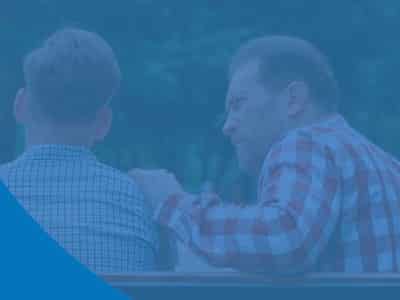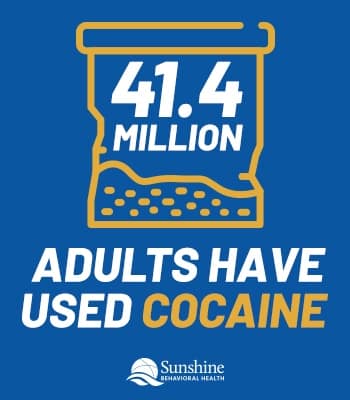
Cocaine Addiction Statistics in Adults
The National Survey on Drug Use and Health (NSDUH) is one of the major sources for detailed information about drug use in the United States.
According to the survey:
- About 1.8 million U.S. residents aged 12 or older used cocaine during the past month in 2016.
- About 1.9 million people used cocaine in the previous month in 2019.
While more people over the age of 25 use cocaine, as a percent of population, younger adults aged 18-25 are more likely to use cocaine regularly, reported the NSDUH survey.
Cocaine Use Statistics by Age
Although it’s a dangerous illegal drug, many people still use cocaine. The Substance Use Disorder and Mental Health Administration (SAMHSA) reported that in 2019, 41.4 million U.S. residents over the age of 12 had used cocaine at least once in their life, and 1.9 million people had used cocaine at least once during the prior month.
SAMHSA reported that .7% of young adults from the ages 18 to 25 were diagnosed with a cocaine use disorder in 2019, compared with .3% of people age 26 and older. Fewer than .1% of teens ages 12 to 17 were diagnosed with cocaine use disorder in 2019. This represents a significant decline from the early 2000s, when between .3% and .4% of adolescents were diagnosed with cocaine use disorders.
Statistics About Cocaine in Seniors
A 2020 report prepared by the National Institute on Drug Abuse reported that senior citizens used cocaine together with other drugs. People over age 65 who used marijuana were eight times greater chance of using cocaine than those who did not use marijuana.
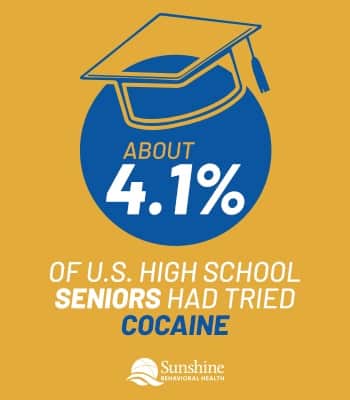
Statistics of Cocaine in Teens
How many teenagers use cocaine? According to the 2015 Monitoring the Future Study, about 4.1% of U.S. high school seniors had tried cocaine at least once in their life, and 2.9% had used it during the past year.
Researchers with the Monitoring the Future study have also analyzed drug use among eighth and 10th graders and found that 1.6% of teens at both grade levels had tried cocaine at some time in their life. Fewer than 1% of 12th graders had used cocaine during the past month.
Stats on crack cocaine among U.S. students indicate that fewer use that version of cocaine. According to statistics, 1% or fewer of eighth-grade, 10th-grade, and 12-grade students reported using crack cocaine in the last year.
Cocaine Use Stats by Gender
More adult men than women tend to use cocaine, according to National Survey on Drug Use and Health (NSDUH) surveys. The 2019 survey reported that 3,382,000 men and 2,086,000 women U.S. residents aged 12 and older used cocaine. The numbers were closer among younger people (12 to 17 years old). In this group, 51,000 young women used cocaine in 2019, compared to 46,000 young men.
NSDUH survey data indicated that 65,000 more men over the age of 26 reported using cocaine in 2019 compared to 2018 (2,322,000 in 2018 and 2,257,000 in 2019). Women reported comparable totals, as 67,000 more used cocaine in 2019 than they did in 2018 (1,260,000 versus 1,193,000).
Cocaine Usage Statistics in Pre-Pubescents
There are several surveys that track drug use in teens ages 12 to 17.
According to the National Institute on Drug Abuse (NIDA), there are about 750,000 babies born from cocaine-exposed pregnancies each year. Most older children who are treated for cocaine use or exposure are accidentally exposed, or they obtain the drug by living with adults who have drug problems.
Such exposure can cause consequences. A 2021 study published in the Journal of Pediatrics found that emergency room admissions for suspected stimulant overdoses, including cocaine, increased 3.3% for newborns through 102025olds between 2016 and 2019.
Unintentional exposure to cocaine is relatively rare, but for children it can be serious. Children exposed to cocaine may be at risk for life-threatening symptoms such as seizures and irregular heart rates.
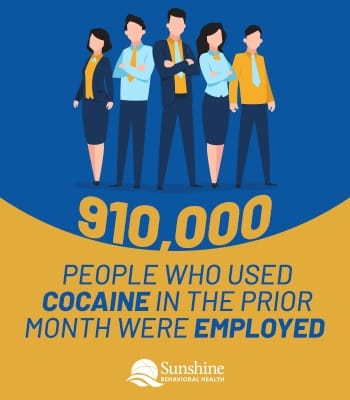 Cocaine Facts and Stats by Employment Status
Cocaine Facts and Stats by Employment Status
The 2019 Survey on Drug Use and Health found that 710,000 people who used cocaine in the prior month were employed full-time. Nearly 200,000 people who used cocaine in 2019 were employed part-time, while 121,000 people were unemployed.
Another 412,000 people who used cocaine in 2019 belonged to the employment status category known as “other.” This category includes people who are self-employed, retired, on disability, or incarcerated.
Cocaine Addiction Stats by Ethnicity
All ethnicities use cocaine. The 2019 Survey on Drug Use and Health (NSDUH) survey stated that among people who had used cocaine at least once in the prior month, 879,000 were white and not Hispanic or Latino. Other ethnicities’ use of cocaine during the prior month in 2019 included:
- Black or African American: 268,000
- Native American: 5,000
- Native Hawaiian or Pacific Islander: 2,000
- Asian: 49,000
- Hispanic or Latino: 206,000
- Two or more races: 15,000
Cocaine Addiction Stats by Education Level
Researchers have claimed that there’s “an inverse association between cocaine use and educational achievement.” That is, the more education people have, the less likely they are to use cocaine.
People who didn’t graduate from high school used cocaine more consistently during 1979 to 2002, according to the findings of the Survey on Drug Use and Health (NSDUH).
Driving Under the Influence Stats for Cocaine
Driving under the influence of substances is a common and dangerous problem. In 2019, a total of 2.27 million people drove under the influence of illicit drugs other than alcohol. Selected illicit drugs include cocaine and heroin.
When combined with alcohol, 28.7 million people reported driving under the influence of drugs that included cocaine. Overall in 2019, about 1% of drivers drove under the influence of illicit drugs other than marijuana, including cocaine.
Younger people were more likely to engage in the practice. The group with the highest rate of driving under the influence of illicit drugs was 21 to 25 year-olds. More than 1% of men and .5% of women drove under the influence of illicit drugs, including cocaine, in 2019.
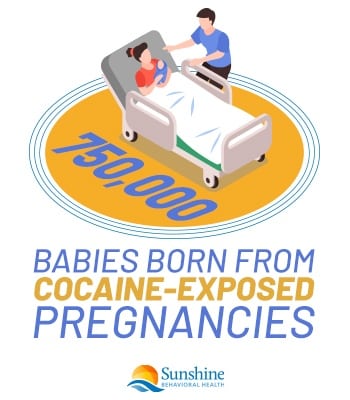 Cocaine Usage by State
Cocaine Usage by State
Cocaine usage varies by different U.S. states. Taking on average of the 2018 and 2019 National Surveys on Drug Use and Health, the U.S. states with the highest average percentage of cocaine use are located in the U.S. West Coast and East Coast and also include Hawaii.
U.S. states with between 2.25 and 4.12% of people over age 12 who used cocaine in 2018 and 2019 include:
- Washington
- Oregon
- California
- Nevada
- Colorado
- New York
- New Hampshire
- Vermont
- Delaware
- Hawaii
States with the lowest rates of cocaine use (1.1 to 1.47%) include:
- Texas
- Idaho
- Utah
- North Dakota
- South Dakota
- Arkansas
- Iowa
- Missouri
- Georgia
- South Carolina
Some Stats About Cocaine
Alcohol was the most common substance college students used while they were driving. Cocaine was the second most common intoxicating substance, according to the results of a 2011 study.
Oregon, Colorado, Arizona, and the states of New England had the highest levels of young adult cocaine misuse in 2014-2015.
Use of stimulant drugs such as cocaine was increasing among U.S. eighth graders in 2020, said the 2020 Monitoring the Future Study.
Surveys indicate that one million people, or 0.4 of the U.S. population 12 or older, had a cocaine use disorder.
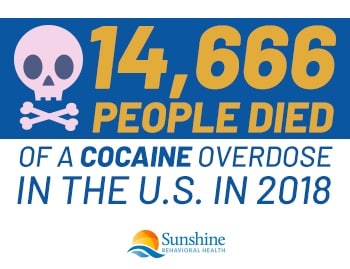 Overdose Statistics
Overdose Statistics
Using and misusing cocaine can cause overdoses and deaths. Data from the Centers for Disease Control (CDC) and Prevention reported on cocaine overdose deaths between 2009 and 2018:
- 14,666 people died of a cocaine overdose in the U.S. in 2018.
- The rate of overdose deaths from cocaine nearly tripled between 2013 and 2018.
- Men were two-and-a-half to three times more likely than women to die of a cocaine drug overdose.
- Adults from the ages of 35 to 44 were at the highest risk for a cocaine overdose at 8.6 people per 100,000.
- Although adults over the age of 65 had a lower risk of death from cocaine overdose, people in the age 55 to 65 age group had as high a rate of increase of overdose death as younger groups, increasing 30% between 2017 and 2018.
- Among different ethnicities, in 2018, non-Hispanic Black people were at the highest risk of cocaine overdose death at a rate of 9.0 per 100,000.
- Non-Hispanic white people had an overdose death rate of 4.6 per 100,000, and Hispanic (non-Black) people had a lower rate of 3.0 per 100,000.
Such statistics indicate the need for timely, effective treatment to treat cocaine abuse and addiction.
Statistics on Cocaine Treatment and Recovery
For people wondering how many people are addicted to cocaine, a total of 1.0 million U.S. residents had cocaine use disorders in 2019, according to the National Survey on Drug Use and Health.
Recovery from substance use disorders involves positive life and health changes, stated the U.S. surgeon general. As of 2019, out of 50 million people in the U.S. who met the criteria for a substance use disorder, about 25 million remained in stable remission of a year or longer.
Well-supported evidence indicates that 12-step mutual aid programs and 12-step facilitation programs can provide effective support for substance use disorder recovery. Early intervention and treatment has proven effective in strengthening recovery for people with substance use disorders.
Although the U.S. Food and Drug Administration (FDA) has approved medications to help people recover from alcohol, tobacco, and opioid use disorders, there are no specific medications available currently for cocaine use disorders. But evidence-based therapeutic interventions in both residential and outpatient settings can help people understand and manage cocaine abuse and addiction.
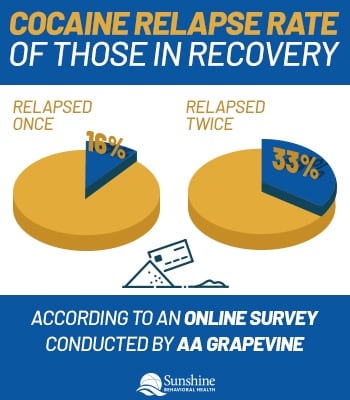 Rates of Relapse
Rates of Relapse
There are few statistics available on the rates of relapse for cocaine use disorders. In general, the National Institute on Drug Abuse (NIDA) has provided education about the role of relapse in recovery and treatment of substance use disorders.
As one example, the NIDA has reported that the rates of relapse for people with substance use disorders are 40 to 60%, figures that are comparable to the relapse rates of other chronic illnesses such as hypertension (high blood pressure) and asthma. People with high blood pressure and asthma experience relapse rates of 50 to 70%.
As a result, people with substance use disorders, including cocaine dependency and addiction, should understand that their disorders are chronic diseases like high blood pressure. Also like blood pressure, there are treatments and resources for managing substance use disorders. YouTube videos, cable news, and opinion-based websites may not have the most up-to-date, reliable, or unbiased information. Government and nonprofit organizations work hard to understand and provide resources to treat substance use, including cocaine addiction and co-occurring mental disorders. Part of the U.S. Department of Health and Human Services, the Substance Use Disorder and Mental Health Services Administration is commonly known as SAMHSA. SAMHSA offers treatment locators for behavioral and substance use disorders at https://www.findtreatment.gov People can also call SAMHSA at 800a662aHELP (4357) The agency also publishes booklets and factsheets, including Tips for Teens About Cocaine. Another government-affiliated agency that addresses substance use disorder and addiction is the National Institute on Drug Abuse (NIDA). NIDA publishes research reports on drugs and addiction. Its resources on cocaine include information about effective treatments. Other useful information from NIDA includes Principles of Drug Addiction Treatment: A Research-Based Guide (Third Edition).
Government Mental Health Resources for Cocaine Addiction
SAMHSA
NIDA
Sources
Medical disclaimer:
Sunshine Behavioral Health strives to help people who are facing substance abuse, addiction, mental health disorders, or a combination of these conditions. It does this by providing compassionate care and evidence-based content that addresses health, treatment, and recovery.
Licensed medical professionals review material we publish on our site. The material is not a substitute for qualified medical diagnoses, treatment, or advice. It should not be used to replace the suggestions of your personal physician or other health care professionals.

